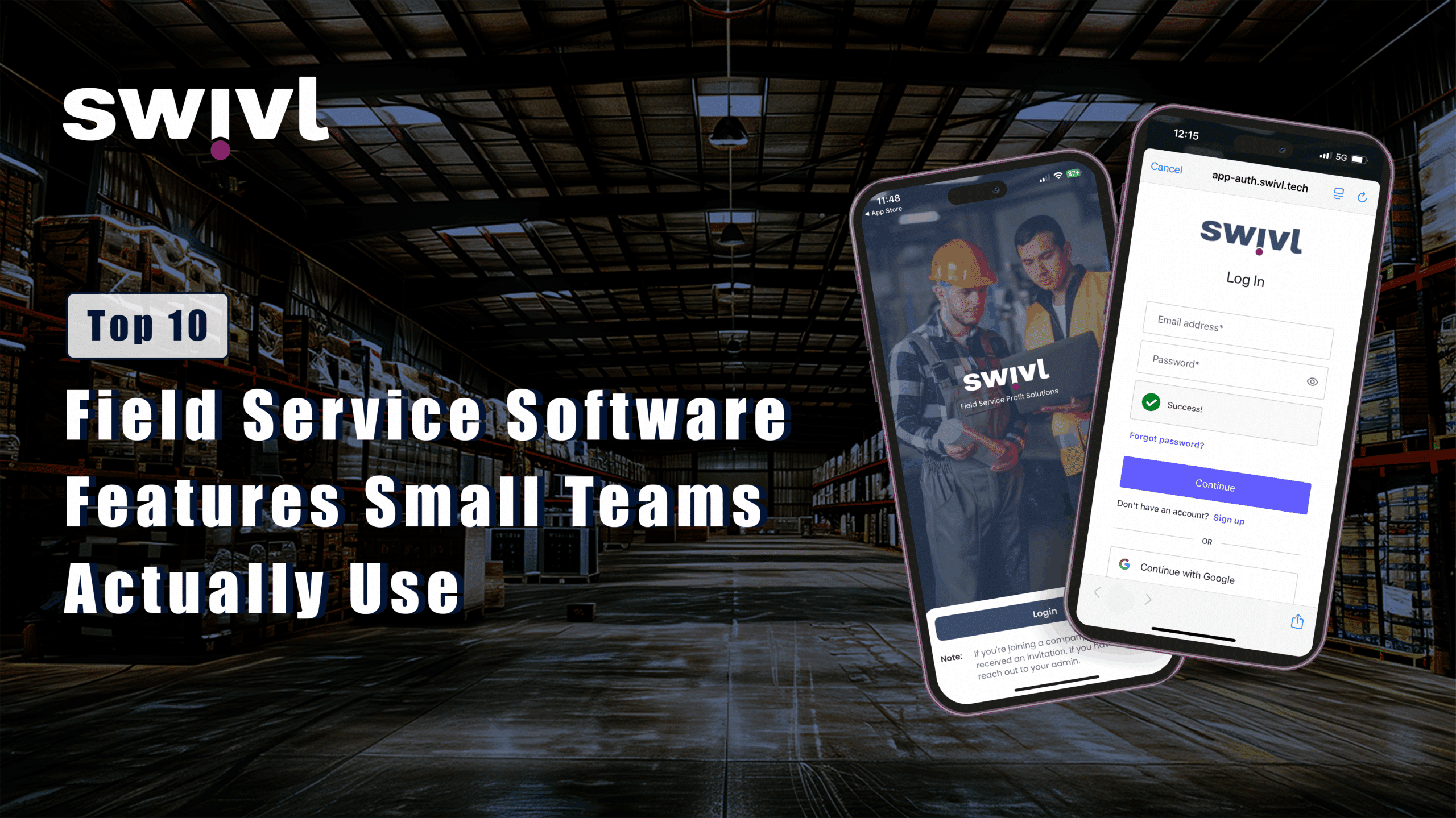In the year 2025, we see a great transformation taking place within the HVAC industry (Heating, Ventilation, and Air Conditioning). With rising customer expectations, increasing regulations, and a shrinking technician workforce, the need for HVAC Service Management Software is no longer optional, it’s essential.
HVAC Service Management Software ranks among the most important causes leading to this change. The said software helps companies become intelligent, fast, and efficient. But how does one go about choosing software that suits one’s needs and organisation?
This article will discuss what HVAC service software is, why it is crucial in the year 2025, and some of the most compelling reasons why your company must have one.
What is HVAC Service Management Software?
A modern Field Service Management (FSM) system comes equipped with several core modules that work together to streamline business operations. Work Order Management forms the foundation by enabling teams to efficiently create, assign, and track jobs from start to finish. It ensures that nothing falls through the cracks and that every task has clear ownership and deadlines.
Dispatching and Scheduling features help get the right technician to the right job at the right time, using tools like real-time calendars, GPS routing, and drag-and-drop job allocation. This improves response time and ensures service-level agreements are met.
Integrated Customer Relationship Management (CRM) tools allow you to keep track of all customer interactions, service history, and job notes in one place. This builds trust and makes future engagements more personalised and efficient.
FSM platforms also simplify Invoicing and Billing by allowing technicians to generate estimates, capture customer approvals, and process payments, all on the go. This reduces delays and administrative overhead.
With Inventory and Asset Tracking, businesses can manage tools, parts, and equipment across different vans, teams, or locations. This prevents stockouts, controls costs, and ensures technicians are always properly equipped for the job.
Another major advantage is Mobile Field Access, giving technicians the ability to access job details, upload photos, and update job status in real time, all through a mobile app. This keeps the back office and field team perfectly in sync.
Modern platforms like Swivl are built specifically for HVAC workflows, ensuring your team operates at peak efficiency with minimal manual intervention.
5 Reasons Why HVAC Businesses Need a HVAC Field Service Management Software in 2025
With rapid change, it has rendered traditional means of carrying out HVAC operations inefficient. Here are four reasons why software is not optional but rather essential:
1. Smaller Workforce, Bigger Demand
The HVAC talent pool is shrinking while service demand keeps growing. With ongoing technician shortages, companies must rely on software to streamline operations. Tools like Swivl use AI to match the right technician to the right job based on location, availability, skill, and urgency, boosting first-time fix rates.
2. Customers Expect Instant Gratification
Today’s customers demand speed, transparency, and convenience. They want to book appointments online, receive real-time updates about technician arrival, and pay digitally all from their phones. HVAC software equipped with customer portals and CRM tools helps you offer a seamless, connected experience that keeps customers coming back.
3. Compliance Isn’t a Choice—It’s a Mandate
From refrigerant regulations to safety protocols and local codes, compliance is stricter than ever. HVAC software automates the capture of job details, technician certifications, and service logs, keeping you audit-ready without drowning in paperwork. It helps businesses stay ahead of the curve—and out of trouble.
4. Turn Data Into Decisions
You can’t improve what you don’t measure. Modern HVAC platforms offer advanced dashboards that track everything from technician efficiency and job profitability to maintenance trends and customer satisfaction. These insights empower smarter decisions that reduce costs, improve service, and drive long-term growth.
5. The Competition Is Already Using It
The top-performing HVAC businesses are already using digital tools to outpace competitors. From AI-powered scheduling to mobile-first job tracking, software isn’t just a tool, it’s the foundation of competitive advantage in 2025. Falling behind in technology means losing business to those who didn’t.
Important Features to Look for in HVAC Service Software in 2025
Set against the increasingly technology-oriented nature of the HVAC industry, selecting the right service management software can make a huge difference in your business. The best platforms in 2025 offer end-to-end solutions that involve AI, mobile access, real-time data, and automation, besides simple scheduling or invoicing. The 10 must-have features to look for when picking your HVAC service software in 2025 include:
1. AI-Powered Scheduling and Dispatching
Modern HVAC platforms are leveraging artificial intelligence to automate and optimise dispatch operations. These smart systems consider variables like technician availability, location, skill set, traffic conditions, and task urgency to assign jobs intelligently. This leads to shorter travel times, fewer scheduling conflicts, and improved first-time fix rates—all contributing to better technician utilisation and faster service delivery.2. Mobile App with Offline Functionality
In the field, cellular signals aren’t always reliable. That’s why a robust mobile app with offline access is critical. Technicians must be able to view job details, update task status, capture signatures, and upload site photos, even in low-connectivity zones. Once back online, all data syncs automatically with the cloud, ensuring nothing is lost.3. Integrated CRM and Customer Portals
Customer relationships define the success of any HVAC business. A well-integrated CRM system helps manage service histories, automate follow-ups, and offer clients access to a self-service portal. Customers can book appointments, approve estimates, and track technician ETAs digitally, enhancing their experience while reducing administrative effort on your end.
4. Real-Time Inventory and Asset Management
Nothing slows down service like missing parts. Real-time inventory tracking ensures technicians have what they need before heading to a job site. A good system connects warehouses, trucks, and field teams to monitor parts movement, flag low stock levels, and assign tools to specific jobs or assets, reducing delays and increasing service reliability.5. Streamlined Billing and Payment Integrations
Delayed payments can cripple cash flow. That’s why invoicing and payment features must be built into your HVAC software. The ability to send digital invoices with embedded payment links, integrate with accounting tools like QuickBooks or Zoho, and accept UPI, credit, or bank transfers ensures a smooth financial workflow for both recurring and one-off jobs.6. Automated Work Orders and Maintenance Scheduling
Recurring maintenance contracts are the backbone of many HVAC businesses. Your software should automatically generate work orders according to predefined service intervals. Features like SLA tracking, renewal reminders, and customizable templates help reduce admin workload and maintain consistent service delivery without any manual follow-up.7. Compliance, Safety, and Documentation
As safety regulations grow more complex, your HVAC software must help you stay audit-ready. Built-in checklists for routine inspections, refrigerant tracking, OSHA compliance features, and digital PDF reports not only help you meet regulatory standards but also build trust with clients by demonstrating diligence.8. Smart Analytics and KPI Reporting
Data-driven decisions are non-negotiable in 2025. Leading platforms offer dashboards and reports covering job duration, technician productivity, cost vs. revenue trends, and customer satisfaction metrics. These insights help you identify inefficiencies, improve service quality, and scale operations with confidence.9. Seamless Integrations and Open APIs
Your HVAC software shouldn’t operate in a silo. It should integrate with third-party apps like accounting software, marketing tools, GPS tracking, or communication platforms. Open API access is ideal if you want to customise your stack and connect to internal systems.10. Security, Scalability, and Support
Security has never been more important. Your platform should include features like two-factor authentication, role-based access control, and GDPR/HIPAA compliance. Scalable cloud infrastructure ensures that the system grows with your business, while reliable customer support and training resources help teams onboard smoothly and troubleshoot when needed.Top HVAC Software Platforms in 2025 (Quick Mentions)
The right HVAC software can make or break your operations in 2025. While there are plenty of platforms on the market, most are either built for enterprise-level businesses or come with high monthly subscription costs that small and growing teams can’t always justify.
That’s where Swivl stands out.
Swivl: Best Free HVAC FSM Solution for Growing and Modern HVAC Teams
Swivl is the only platform purpose-built for small and mid-sized HVAC businesses that want enterprise-grade features without being locked into expensive monthly plans. With a pay-as-you-use pricing model and no subscription commitment, Swivl helps HVAC businesses scale efficiently, stay lean, and win more jobs, without burning through budgets.
Why HVAC pros love Swivl:
- 100% Free to Start: No monthly subscriptions. Use only what you need, when you need it.
- Mobile-First Job Management: Technicians can view jobs, upload photos, update status, and collect signatures, all from their phones, even offline.
- Smart Dispatching & Scheduling: Assign the right technician to the right job based on skill, location, and availability using AI-powered tools.
- Built-In Invoicing & Estimates: Instantly generate, send, and get paid for jobs—right from the field. Integrated with tools like QuickBooks.
- Integrated CRM: Track service history, automate follow-ups, and let clients approve quotes or schedule jobs online.
- Actionable Dashboards & Reports: Visualize technician productivity, job margins, and customer satisfaction to optimize operations.
- Secure & Scalable: Role-based access, data encryption, and cloud infrastructure that grows with your business.
Other Mentioned HVAC Software Platforms in 2025
| Software | Best For | Key Highlights |
| ServiceTitan | Large enterprises | Enterprise-grade FSM with advanced reporting, complex workflows, and high pricing. |
| Jobber | Small to mid-sized teams | Simple scheduling, invoicing, and basic CRM features. |
| FieldEdge | Growing contractor operations | Mobile functionality with QuickBooks sync. |
| Housecall Pro | Individual pros & freelancers | Lightweight tool with basic appointment features and mobile access. |
Conclusion
The HVAC industry is undergoing a critical transformation in 2025—from reactive fixes to proactive maintenance, from paper-based tracking to real-time digital platforms. Adopting HVAC Service Management Software is no longer a luxury, it’s a necessity for growth, efficiency, and long-term survival.
Making the shift to automation, mobile accessibility, improved customer experience, and data-driven operations is what sets future-ready companies apart from the rest. But before you commit to a platform, ask yourself:
- Is this solution scalable as my business grows?
- Does it match my team’s comfort with digital tools?
- Will it streamline tasks for both my office staff and field technicians?
Choose smart. Train your team. Embrace the digital HVAC revolution. Because the sooner you switch, the sooner you save time, reduce errors, and serve customers better.




